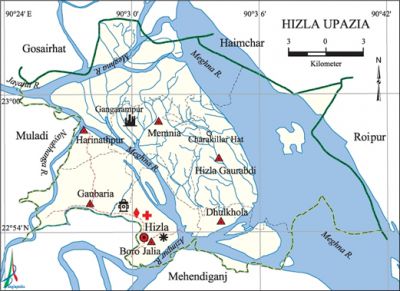Hizla Upazila
Hizla Upazila (barisal district) area 515.36 sq km, located in between 22°50' and 23°05' north latitudes and in between 90°25' and 90°43' east longitudes. It is bounded by gosairhat and haimchar upazilas on the north, mehendiganj upazila on the south, raipur upazila on the east, muladi upazila on the west.
Population Total 146077; male 72789, female 73288; Muslim 142419, Hindu 3654, Christian 3 and others 1.
Water bodies Main rivers: meghna, Jayanti, Naiyabhanga and Azimpur.
Administration Hizla Thana was established in 1911 and it was turned into an upazila in 1983.
| Upazila | ||||||||
| Municipality | Union | Mouza | Village | Population | Density (per sq km) | Literacy rate (%) | ||
| Urban | Rural | Urban | Rural | |||||
| - | 6 | 92 | 94 | 14184 | 131893 | 283 | 56.4 | 39.1 |
| Upazila Town | ||||||||
|
Area |
Mouza |
Population |
Density |
Literacy rate (%) | ||||
| 8.36 | 3 | 14184 | 1697 | 56.4 | ||||
| Union | ||||
| Name of union and GO code | Area (acre) | Population | Literacy rate (%) | |
| Male | Female | |||
| Guabaria 54 | 16055 | 14319 | 15601 | 50.9 |
| Dhulkhola 27 | 9880 | 6928 | 6471 | 43.5 |
| Bara Jalia 13 | 14079 | 15711 | 15932 | 56.4 |
| Memania 94 | 17290 | 12387 | 12348 | 31.2 |
| Harinathpur 67 | 14820 | 12062 | 12564 | 45.1 |
| Hizla Gaurabdi 81 | 17784 | 11382 | 10372 | 22.7 |
Source Bangladesh Population Census 2011, Bangladesh Bureau of Statistics.

Archaeological heritage and relics Stone statue of Vasu Deva (Gobindapur).
War of Liberation During the war of liberation in 1971 the local freedom fighters led by base commanders Kutub Uddin and Kazi Anwar Bir Pratik carried out operations against the Pak army in the Hizla-Muladi region. Most of the operations were led by Kutub Uddin and Abdus Kuddus Molla. During the War of Liberation a number of freedom fighters including Havildar Shah Alam, Nayek Azizur Rahman, Havildar Nur Muhammad and Sepahi Abdul Wazed were killed in encounters with the Pak army. The Pak army killed eight persons including Hossain Ali (teacher) of Palpara and Sultan Jamadar of Dadpur. A memorial monument has been built in the upazila.
For details: see হিজলা উপজেলা, বাংলাদেশ মুক্তিযুদ্ধ জ্ঞানকোষ (Encyclopedia of Bangladesh War of Liberation), বাংলাদেশ এশিয়াটিক সোসাইটি, ঢাকা ২০২০, খণ্ড ১০।
Religious institutions Mosque 326, temple 12. Noted religious institutions: Muslim Zamindar Bari Mosques at villages Sreeram Pur and Shahjahan Pur, Sultan Khan Mosque and dargah at village Gangapur.
Literacy rate and educational institutions Average literacy 40.8%; male 39.2%, female 42.4%. Educational institutions: college 1, secondary school 18, primary school 88, madrasa 41. Noted educational institutions: Hizla College, Kakuria Bandar Secondary School, Sanhati Pilot Secondary School, Mahishkhola Senior Madrasa.'
Newspapers and periodicals Hizla Upazila Barta.
Cultural organisations Cub 3, library 14, woman organisation 2, cinema hall 1, playground 10.
Main sources of income Agriculture 73.43%, non-agricultural labourer 2.61%, industry 0.56%, commerce 10.7%, transport and communication 1.02%, service 5.72%, construction 1.20%, religious service 0.31%,, rent and remittance 0.80% and others 3.65%.
Ownership of agricultural land Landowner 66.05%, landless 33.95%; agricultural landowner: urban 66.06% and rural 66.05%.
Main crops Paddy, jute, sugarcane, turmeric, potato, vegetables.
Extinct or nearly extinct crops Suryamukhi, mug, kaun, china, hogla leaf.
Main fruits Mango, jackfruit, banana, plum, litchi, black berry, palm, date, coconut, papaya, betel nut, hog plum.
Fisheries, dairies and poultries Fishery 4, Dairy 20, poultry 40.
Communication facilities Pucca road 25 km, semi-pucca road 48 km, mud road 270 km; waterways 180 km.
Extinct or nearly extinct traditional transport Palanquin, bullock cart.
Noted manufactories Rice mill, bidi factory, welding factory.
Cottage industries blacksmith, potteries, fishing-net factory, nakshi kantha, bamboo and carne work, handicrafts of jute, pati and madur industries, sugarcane molasses processing factory, shital pati.
Hats, bazars and fairs Hats and bazars are 35, most noted of which are Dhanushikder Hat, Puran Hizla Hat, Charkillar Hat, Mollar Bazar, Ekota Bazar, Kaisma Bazar.
Main exports Milk products, hog plum, shital pati, shrimp, betel nut,' rice.
Access to electricity All the unions of the upazila are under rural electrification net-work. However 41.4% of the dwellings have access to electricity.
Sources of drinking water Tube-well 87.8%, tap 0.3% and others 11.9%.
Sanitation 80.1% of dwelling households of the upazila use sanitary latrines and 18.6% of dwelling households use non-sanitary latrines; 1.3% of households do not have latrine facilities.
Health centres Upazila health complex 1, family planning centre 5, satellite clinic 1.
Natural disaster The cyclone of 1960 and the tidal bore of 1971 caused heavy damages to settlements, livestock and properties of the upazila. Besides, many people died of starvation during the famine of 1962.
NGO activities Disha, Alor Disha. [KM Saiful Islam]
References Bangladesh Population Census 2001 and 2011, Bangladesh Bureau of Statistics; Cultural Survey report of Hizla Upazila 2007.
